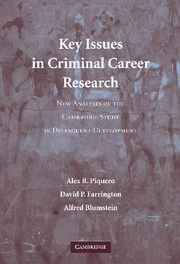 Key Issues in Criminal Career Research
Key Issues in Criminal Career Research Published online by Cambridge University Press: 30 July 2009
This chapter aims to compare prospective (proximate) onset ages with retrospective (distant) and official onset ages for different offense types. The key question addressed here is how much retrospective and official onset ages agree with prospective ages, which are assumed to be the most accurate.
Age of onset, the age at which offending behavior begins, is a central concept in criminal career research. Some studies have explored the predictors of onset (Farrington and Hawkins, 1991; Farrington et al., 1990; Nagin and Farrington, 1992a), whereas others have focused on the impact of early onset on later features of criminal careers (see Chapter 5). Age of onset is one of the best predictors of the length and intensity of the criminal career (Blumstein et al., 1985; Farrington, 1973; Farrington and Hawkins, 1991; Farrington et al., 1990, 1998, 2003; Le Blanc and Fréchette, 1989; Loeber and Le Blanc, 1990). Research has also shown that a later onset can have a considerable favorable impact on the later criminal career (Farrington et al., 1990).
Farrington (1989) showed that the age-crime curve differed from one offense type to another. This suggests that the age of onset may vary from one offense category to another, although this aspect of criminal career research has been somewhat neglected (see Jolliffe et al., 2003; Le Blanc and Féchette, 1989).
To save this book to your Kindle, first ensure [email protected] is added to your Approved Personal Document E-mail List under your Personal Document Settings on the Manage Your Content and Devices page of your Amazon account. Then enter the ‘name’ part of your Kindle email address below. Find out more about saving to your Kindle.
Note you can select to save to either the @free.kindle.com or @kindle.com variations. ‘@free.kindle.com’ emails are free but can only be saved to your device when it is connected to wi-fi. ‘@kindle.com’ emails can be delivered even when you are not connected to wi-fi, but note that service fees apply.
Find out more about the Kindle Personal Document Service.
To save content items to your account, please confirm that you agree to abide by our usage policies. If this is the first time you use this feature, you will be asked to authorise Cambridge Core to connect with your account. Find out more about saving content to Dropbox.
To save content items to your account, please confirm that you agree to abide by our usage policies. If this is the first time you use this feature, you will be asked to authorise Cambridge Core to connect with your account. Find out more about saving content to Google Drive.